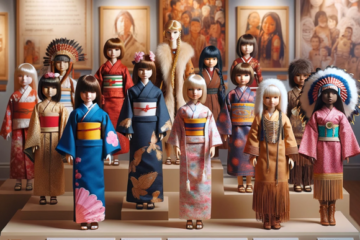Dolls, seemingly simple toys, hold profound significance in the intricate tapestry of human culture. Beyond their role as playthings, they serve as mirrors reflecting the diverse identities, beliefs, and traditions of societies worldwide. From the delicate porcelain dolls of Victorian England to the elaborately crafted kokeshi dolls of Japan, each doll encapsulates a piece of cultural heritage, weaving a narrative of identity and belonging.
A Journey Through Time and Culture
The history of dolls intertwines with the evolution of human civilization. Archaeological findings reveal the existence of rudimentary dolls dating back thousands of years, crafted from materials such as clay, wood, and even stone. These ancient artifacts offer glimpses into the lives and cultures of bygone eras, shedding light on the values and beliefs that shaped human existence.
As civilizations flourished, so too did the artistry and craftsmanship associated with doll-making. In every corner of the globe, artisans infused their creations with elements unique to their cultural identity. Whether it be the colorful textiles of African doll makers or the intricate beadwork of Native American artisans, each doll served as a vessel for cultural expression, preserving traditions passed down through generations.
Reflections of Self and Society
Dolls not only reflect cultural identity but also play a crucial role in shaping individual and societal perceptions of identity. For children, dolls serve as companions and confidants, embodying ideals of beauty, behavior, and societal roles. Through play, children navigate complex concepts of self-image and belonging, drawing upon the characteristics imbued in their dolls to construct their own identities.
However, the relationship between dolls and identity extends beyond childhood play. In adulthood, dolls can evoke nostalgia, serving as tangible reminders of cultural heritage and personal history. Collectors often seek out dolls that resonate with their own backgrounds, finding solace and connection in these tangible representations of identity.
Challenges and Controversies
Despite their cultural significance, dolls have also been at the center of controversy, particularly regarding issues of representation and inclusivity. Historically, many dolls have perpetuated narrow standards of beauty and societal norms, marginalizing individuals whose identities diverge from these ideals.
In recent years, however, there has been a growing movement towards greater diversity and inclusivity in doll-making. Companies have begun producing dolls representing a broader range of ethnicities, body types, and abilities, reflecting the rich tapestry of humanity. These efforts not only promote positive self-image and acceptance but also foster a more inclusive society that celebrates the myriad facets of cultural identity.
Looking Ahead: A Tapestry of Diversity
As we journey into the future, the relationship between dolls and cultural identity will continue to evolve, reflecting the ever-changing landscape of society. With each new generation, dolls will serve as both mirrors and milestones, reflecting our progress towards a more inclusive and accepting world.
In the end, whether crafted from clay or molded from plastic, dolls transcend their material form, embodying the essence of human experience. They remind us that our identities are not fixed but fluid, shaped by the cultures we inherit and the societies we create. In this interplay of tradition and innovation, dolls stand as timeless witnesses to the beauty of diversity and the enduring power of cultural identity.



0 Comments